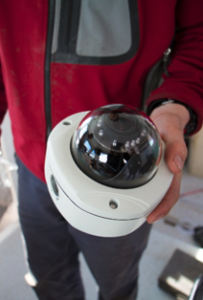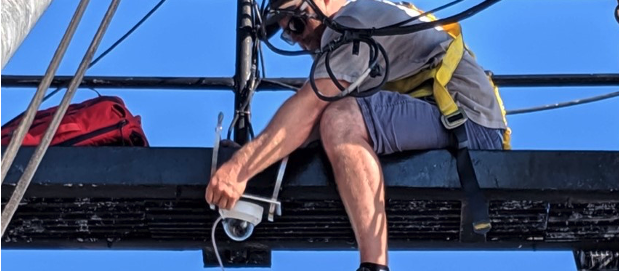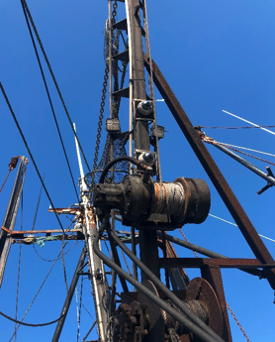Starting in 2013, the Gulf of Maine Research Institute (GMRI) has worked with several project partners to develop electronic monitoring (EM) as a cost-effective catch accounting tool for the Northeast Multispecies (Groundfish) Fishery. GMRI’s focus on EM has been an extension of larger engagement with the fishery as it has transitioned from days-at-sea management to the sector-based system implemented in 2010. Under sector management, vessels may elect to join a harvesting cooperative, known as sector, and be exempted from days-at-sea. Sectors receive an annual allocation of groundfish stocks based on the catch history of its members. Vessels then fish against their portion of that allocation. Vessels must retain all legal-sized fish and discard undersized fish*. Both count against the vessel’s allocation. At-sea monitoring determines the species and weight of discards.
GMRI’s initial EM project, with the Maine Coast Fishermen’s Association and The Nature Conservancy (TNC), is now known as the audit model and led by Cape Cod Commercial Fishermen’s Alliance and TNC. The audit model replaces human at-sea monitors with a camera system that captures the length and species of every discarded fish. It works well on day boats and other vessel handling lower catch volumes.
In 2018, GMRI shifted focus to a retention-based model, the Maximized Retention EM Program (MREM), as an option for vessels processing higher volumes of catch, where measuring each discarded, undersized fish is not practical. With funding from the National Fish and Wildlife Foundation, GMRI contracted with several service providers, including New England Marine Monitoring and CVision AI, to develop and implement MREM. TNC joined the project in 2021, bringing extensive expertise in implementing EM. NOAA Fisheries staff, from both the Northeast Fishery Science Center and the Greater Atlantic Regional Fisheries Office, have been key partners to develop program protocols and standards. Absolutely critical to the program have been the vessel owners, captains, and crew who have fished under MREM and committed their time and expertise to making it work.

MREM has two components: electronic monitoring at-sea and dockside monitoring at the offload. Vessels participating in MREM retain all allocated groundfish regardless of size or condition. The EM system is used to verify the retention of allocated groundfish. On each fishing trip, allocated groundfish are tallied at the offload via the dealer report, which is verified by a dockside monitor. Dealers record all catch, including undersized groundfish, creating a complete record for each fishing trip.
In October of 2020, the New England Fishery Management Council adopted Amendment 23 to the Northeast Multispecies Fishery Management Plan, calling for 100% at-sea monitoring in the fishery. The amendment specifies both the audit model and MREM as allowable alternatives to human monitors. In April 2022, NOAA approved Amendment 23. EM development, including the MREM program, continues to help industry and NOAA fisheries achieve accurate and cost-effective catch accounting.
Evolution of the MREM Model
During the first few years of the program, GMRI worked with several mid-sized boats to test retention-based EM in the region’s groundfish fishery. During the 2020 fishing year, several large-volume offshore vessels joined the program. A key part of scaling the program was offering incentives, including two mesh size exemptions, through the MREM’s federal project permit. Early conversations with interested industry members revealed concerns around the hold space needed to retain the sub-legal groundfish catch. These incentives, in part, allowed interested participants to take on the risk of testing the MREM pilot project.
Through the 2021 fishing year, project partners successfully scaled the MREM model, refined catch handling and dockside monitoring protocols to work on higher volume vessels, and worked through hurdles for fully implementing MREM. Industry members also played a key role in program development and provided feedback during several program meetings throughout the 2018-2021 fishing years.
Program details
Under GMRI’s federal exempted fishery permit, the pilot program is capped at eight vessels participating at one time. Eleven vessels and nine dealer operations from Rhode Island, Massachusetts, and Maine, and representing a variety of fishing and offload strategies, have participated thus far. Many of those vessels have been enrolled for multiple fishing years. Overall, the program has covered over 600 sea-days.
Typically, vessels have four cameras installed to cover the entire back deck and provide detailed views of predetermined discard points (where non-allocated groundfish and non-groundfish species may be discarded). Cameras and a dedicated GPS receiver are linked to a central server, which controls the system. A live feed is visible on a screen, giving the captain a view of the deck and the capability to monitor EM system function throughout a fishing trip
Video is currently stored on hard drives, offering a cost-effective method for collecting and storing high-quality video footage. Vessels ship their hard drives to the EM service provider right after each trip. With this system, data collection, video review, and trip report submission are timely and allows EM data to quickly enter into management processes and ensure rapid feedback to vessel participants.
For the first few years of the MREM program, GMRI contracted directly with New England Marine Monitoring to outfit vessels with EM systems and to provide technical and video review services for MREM fishing trips. Starting with the 2021 fishing year (May 2021-April 2022), EM programs, including those run under federal exempted fishing permits, became reimbursable under the federal at-sea monitoring funding structure. Thus, service providers now contract directly with groundfish sectors.
GMRI and service providers meet with interested vessels to discuss the deck layout and catch flow and determine where providers should install cameras. Once the EM system is installed, the provider trains the captain and crew on using the system and reviewed catch handling requirements. A vessel monitoring plan is customized for each participating vessel, outlining the vessel’s roles and responsibilities for participating in MREM along with vessel-specific EM system layouts and deck layouts. Once the NOAA approves the vessel’s monitor plan, the vessel undertakes a burn-in trip to test the system and is then enrolled in and the MREM program.
After the vessel becomes fully enrolled in the program, the service provider begins conducting video review for each trip and submits a trip summary to NOAA. The trip summary is alphanumeric data, including information on sail dates, the number of hauls, any deviations in EM system functionality, and an overview of any allocated groundfish discards observed on a trip.

Key Take-Aways
EM system function
We found that the EM systems scaled well to cover the deck operations of larger volume vessels and that most systems needed four cameras. Vessels are required to sail with a functioning EM system, and throughout the program, it has been apparent that EM systems are robust, even in offshore conditions. On one winter fishing trip, a camera was covered in ice, and continued to record. Because of the longer fishing trips and drain on power sources from additional equipment, a backup power supply is installed to keep the EM system running throughout fishing trips.
Retention of Allocated Groundfish
Crews were good at adhering to the vessel monitoring plans, and reviewers could identify and track discarded fish. Despite good catch handling, a small number of groundfish discards occur on most fishing trips. Most groundfish discarding happen for various operational and procedural reasons, such as falling out of the net during haul-back or sloshing over the side during sorting. Relative to the volume of the landed catch, these operational discards are very low.
A few industry members expressed concerns about retaining sub-legal-sized groundfish, and several interested operators were not able to commit to the program because of concerns over filling limited hold space with sublegal groundfish. For a majority of MREM trips, for vessels targeting haddock, redfish, and mixed groundfish, the volume of the sub-legal catch was low and manageable for crews to handle.
Camera Maintenance
EM systems continue to capture high-quality video under various sea-state conditions, including fishing at night. However, camera maintenance directly impacts review time. Cameras kept clean throughout fishing trips often lead to faster video review. High-volume vessels are required to maintain their accessible cameras frequently throughout the fishing trip, and a live view was installed in the wheelhouse monitor to assist with system evaluation.

Lastly, we found that NOAA guidance and protocols impacted video review time and cost. Reviewing EM videos is a significant cost, especially in the MREM program, where fishing trips are multiple days. GMRI and NOAA project partners continued to refine protocols to work towards efficient protocols that meet program requirements. As we continue to develop the program and support the capacity for the EM program, we hope to keep conversations around costs and protocol development going and continue to drive down the costs of EM in the region. EM data provides an opportunity to collect a lot of high-quality information, and conversations around using the data for the purposes of catch accounting, and questions around data policy continue to be key to the success of EM implementation as EM program operationalize in New England.
Next steps
Once Amendment 23 is fully implemented, the at-sea portion of MREM will be operational and vessels will not require GMRI’s exempted fishing permit to us the system for catch accounting. NOAA Fisheries staff still oversee the dockside monitoring portion of MREM. During the 2022 fishing year, GMRI and TNC will be contracting with monitoring providers to develop the standards for an independent dockside monitoring program to go into effect beginning in with fishing year 2023.
_ _ _
* several species are under a strict rebuilding program and are therefore not allocated and must be discarded regardless of size: ocean pout, wolffish, and windowpane flounder. Only one Atlantic halibut may be retained per trip.
_ _ _
Elizabeth Moore is Project Manager for the MREM Program and Jonathan Labaree is Chief Community Officer at the Gulf of Maine Research Institute. Both Elizabeth and Jonathan welcome your questions or comments. Projects in the Field is a series of independently produced articles profiling work supported by NFWF’s Electronic Monitoring & Reporting Grant Program, and is meant to raise awareness and support for these important initiatives.


